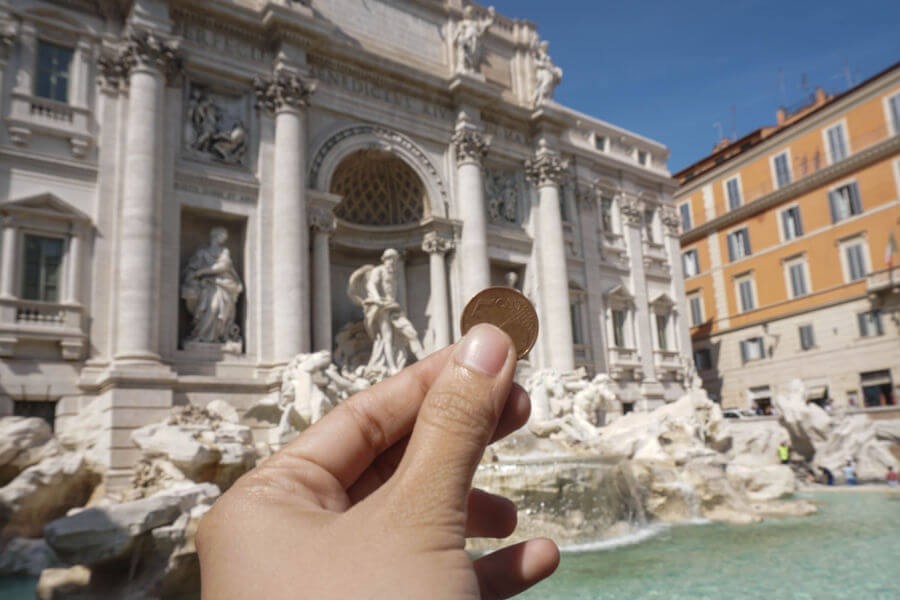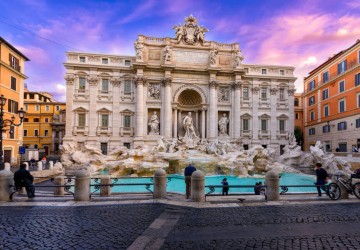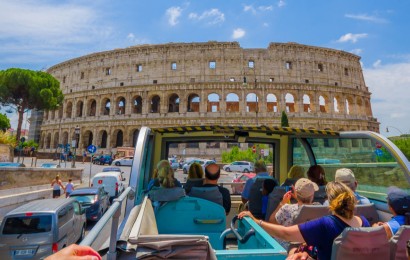The Trevi Fountain is one of the largest and most famous fountains in Rome. It is the exhibition of the Virgin Water (Aqua Virgo), or the aqueduct that Marco Vipsanio Agrippa led to Rome in 19 B.C. to feed its Baths.
His fame is also due to be the frame of a famous scene from the film "La dolce vita" by Federico Fellini.
If you want to admire the beautiful Trevi Fountain we recommend you book our Hop On Hop Off tour. Boarding our open bus at stop number 8 "PIAZZA BARBERINI", you can see not only the Trevi Fountain but also Piazza Barberini, Palazzo Barberini and Palazzo del Quirinale.
Meanwhile, in our article you can learn about the history and some facts about the Trevi Fountain.
The real history of the Trevi Fountain
The history of the Trevi Fountain is closely linked to the restoration of the Acqua Vergine aqueduct.
Following the Gothic Wars (535 - 553 AD), most of the aqueducts, including the Acqua Vergine, were damaged.
Initially, around 1410, the fountain consisted of three vents that poured water into three separate pools side by side. The fountain began to be called "di Trejo" because it was placed in the locality called "dello Trejo", in reference to the "Trivio" (that is, the intersection of three streets).
In 1453 Pope Nicholas V commissioned Leon Battista Alberti to restore the fountain.
The architect replaced the three basins with a single long rectangular basin.
Meanwhile, in our article you can learn about the history and some curiosities about the Trevi Fountain. The fountain began to take shape around 1640 when Pope Urban VIII commissioned Gian Lorenzo Bernini a "transformation" of the square and the fountain. His project involved an extension of the square and the orthogonal overturning of the fountain, obtaining the alignment today, towards the Quirinal.
According to the documentation, the structure included two large semi-circular concentric tanks, which had to give relief to the central statue, placed on a base below the water level, probably representing the virgin Trivia.
Bernini’s work was abandoned for several reasons:
- lack of funds
- death of Pope Umberto VIII
- open trial against the Barberini family by the new Pope Innocent X
With Pope Innocent X, Bernini was entrusted with the simple task of extending the Virgin Water to Piazza Navona, while Francesco Borromini was to create a new monumental exhibition in front of the Palazzo Pamphili.
Since the 18th century, the theme of the Trevi Fountain has been discussed at length and the Academy of St Luke held several competitions.
It was Pope Clement XII who decided the fate of the square and the fountain when in 1731 he held a competition in which the major artists of the time participated. The competition was initially won by the French sculptor Lambert-Sigisbert Adam and then the task passed to the architect Nicola Salvi.
The work was begun in 1732 and in 1759 it was entrusted to Pietro Bracci and his son. The fountain was completed and inaugurated definitively by Pope Clement XIII.
The restoration of the Trevi Fountain
Over the years the Trevi Fountain underwent some important restorations:
- in 1998 a modernization of the plumbing and a cleaning of the fountain was done;
- in 2014 was made a modernization of the square and cleaning and consolidation of the two sides of the fountain, the statues, the cliff of the fountain and carried out a waterproofing of the pool. The restoration lasted seventeen months and was sponsored by Fendi;
- in 2019 renovations of the artistic lighting system were carried out
Trevi Fountain: facts, curiosities and most famous questions

Here you can discover everything about the Trevi Fountain: facts, curiosities, legends and traditions.
We answer to some of the most frequent questions about Trevi Fountain:
- Why is the Trevi Fountain called that?
This fountain owes its name to the place where it was built, formerly called "dello Trejo", in reference to the "Trivio" (ie the intersection of three streets) that corresponded to what is the current Piazza dei Crociferi. - Who lives in the Trevi Fountain Palace?
Palazzo Poli, the palace of the Trevi Fountain, hosted several illustrious artists and writers: Francesco Manno, Peter Cornelius, Gioacchino Belli, Princess Zenaide Wolkonski.
In 1978 the historic building became the property of the Italian State and today is the headquarters of the Central Institute for Graphics. - How much money is inside the Trevi Fountain?
It is estimated that at least one million euros are collected annually. The money collected, according to an agreement between the Capitol and Caritas, is donated to charities. - Why do you throw a coin in the Trevi Fountain?
The coin toss is a classic for those in front of the Trevi Fountain. Doing this act with your eyes closed and turning your back to Palazzo Poli, you will definitely return to the city.
There is another legend according to which, throwing three coins will come true 3 wishes: return to Rome Meet the love of your life marry

